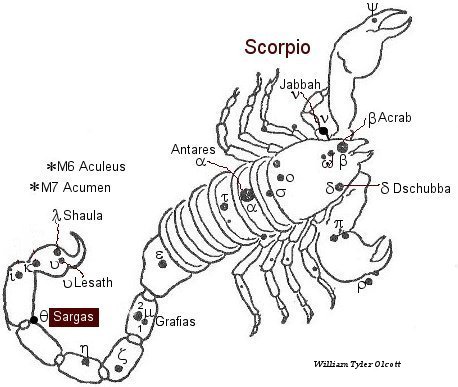| Fixed star: SARGAS | |
| Constellation: Theta (θ) Scorpius | |
| Longitude 1900: 24SAG12 | Longitude 2000: 25SAG36 |
| Declination 1900: -42.56′ | Declination 2000: -42.59′ |
| Right ascension: 17h 37m | Latitude: -19.38′ |
| Spectral class: F0 | Magnitude: 2.0 |
The history of the star: Sargas
from p.369 of Star Names, Richard Hinckley Allen, 1889.
[A scanned copy can be viewed on this webpage
Theta (θ) Scorpius, Sargas, a 2nd-magnitude red star in the tail of the Scorpion.
It was the Euphratean Sargas, lying in the Milky Way just south of lambda (λ Shaula) and upsilon (υ Lesath), with which it formed one of the seven pairs of Twin Stars; as such it was Ma-a-su. And it may have been, with iota (ι), kappa (κ), lambda (λ Shaula) and upsilon (υ Lesath), the Girtab of the lunar zodiac of that valley, the Vanant of Persia and Vanand of Sogdiana (an Iranian people), all meaning the “Seizer,” “Smiter,” or “Stinger”; but the Persian and Sogdian words generally are used for our Regulus. In Khorasmia these stars were Khachman, the Curved.
Star Names, Their Lore and Meaning, Richard Hinckley Allen, 1889].
The astrological influences of the constellation Scorpius
Ptolemy makes the following observations: “The bright stars in the front of the body of Scorpio have an effect similar to that produced by the influence of Mars, and partly to that produced by Saturn: the three in the body itself . . . are similar to Mars and moderately to Jupiter: those in the joints of the tail are like Saturn and partly like Venus: those in the sting, like Mercury and Mars.” By the Kabalists Scorpio is associated with the Hebrew letter Oin and the 16th Tarot Trump “The Lightning-Struck Tower.” [Robson, p.60-61.]
The astrological influences of the constellation Scorpius given by Manilius:
“The Scorpion presides over arms” [Manilius, Astronomica, 1st century AD, book 4, p.253]
“By virtue of his tail armed with its powerful sting, wherewith, when conducting the Sun’s chariot through his sign, he cleaves the soil and sows seed in the furrow, the Scorpion creates natures ardent for war and active service, and a spirit which rejoices in plenteous bloodshed and in carnage more than in plunder. Why, these men spend even peace under arms; they fill the glades and scour the woods; they wage fierce warfare now against man, now against beast, and now they sell their persons to provide the spectacle of death and to perish in the arena, when, warfare in abeyance, they each find themselves foes to attack. There are those, too, who enjoy mock-fights and jousts in arms (such is their love of fighting) and devote their leisure to the study of war and every pursuit which arises from the art of war.” [Manilius, Astronomica, 1st century AD, p.239-240].
References:
Fixed Stars and Constellations in Astrology, Vivian E. Robson, 1923].
